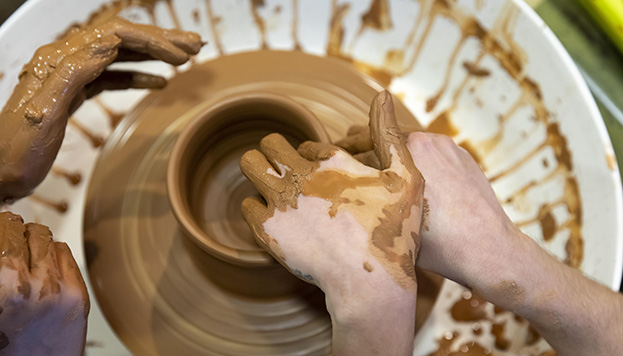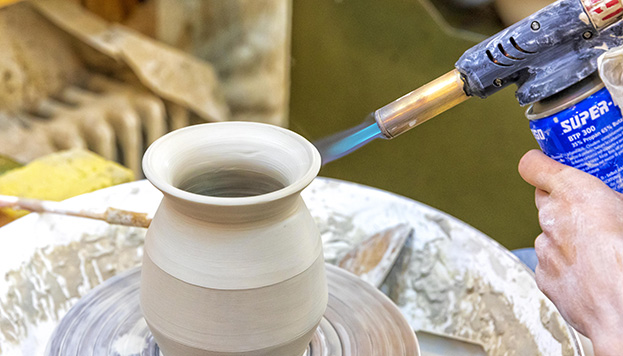
Jandra Cerámica. © Álvaro López del Cerro
Feeling clay between your hands can be quite an experience. Madrid has numerous studios where master artisans work with it to express themselves, but also to make their knowledge of a centuries-old trade accessible to others. Their lives unfold against a backdrop of kilns and potters’ wheels.

Arte Hoy. © Álvaro López del Cerro
Improvements to ovens during the Roman era allowed significant advances to be made in pottery within the boundaries of what we know today as the Community of Madrid. Later on, the clay-rich earth of places like Galapagar was used in a significant number of Arab pottery pieces. In the 16th century, quite a few workshops began to crop up in the vicinity of Madrid. Mule drivers then began to visit the city, their mules laden with goods, to sell pieces for everyday use such as cooking pots and vessels for water and wine. On the initiative of Charles III, the Royal Porcelain Factory of Buen Retiro was created in 1760. Later on, in 1817, it was replaced by the Royal Factory of La Moncloa, an initiative by Maria Isabel of Braganza, the wife of Ferdinand VII. Both factories were tasked with producing porcelain and ceramic items for royal use. The tradition of pottery and ceramics has continued in our city ever since. Many artisans have chosen the trade as a way to give free rein to their creative expression. In their studios, they make and sell pieces, but that’s not all: they also teach. Giving shape to clay alongside master craftspeople can be a wonderful experience.

© Álvaro López del Cerro
“My connection to a slower form of feeling and existing began over ten years ago. That was when I began to make changes in my life, many of which led me away and drew me closer to a philosophy I feel is in tune with humankind. Art and pottery connect me to this way of living life in greater awareness of and in closer harmony with the biological clock. Because clay takes its time; there’s no rushing it”. The speaker of these words, Déborah Abizanda, is a journalist turned ceramicist with a studio-shop a stone’s throw away from the Reina Sofía Museum where she creates and displays her pieces in addition to giving classes on a regular basis. Her work takes two paths: one that’s more functional (crockery, vases, earrings, etc.), for which she finds inspiration in Art Nouveau, Nordic design and Japanese art, and another that’s more artistic, in which she uses “ceramic and materials like paper, wool and cotton to express myself”.

© Álvaro López del Cerro
Silvia Valentín is a Fine Arts graduate, mural painting restorer and archaeologist whose first contact with pottery was at the Francisco Alcántara School of Ceramics, a historic institution in Oeste Park near the building and the kiln of the old Royal Factory of La Moncloa. Silvia creates pieces shaped on a potter’s wheel which she then fires a number of times at a high temperature of 1,250°C. She finishes her simple, sculptural shapes with textures that create a contrast between the rough, barely decorated outer surfaces and the smoother glazed inner surfaces. “I seek expression through irregular volumes that are slightly asymmetrical, with finishes dominated by the colour of clay, among oxides and porcelain”.

© Álvaro López del Cerro
For Alejandra Martínez, nothing is more fun than meeting “the challenges my customers set for me. I enjoy turning their crazy ideas into real pieces that are both functional and decorative”. She began to study ceramics at the age of 16 and is now a true artist who hasn’t stopped creating since then. Particularly outstanding among her pieces are the animals of varying sizes and female gymnasts with generous hips. She also restores furniture and old wooden pieces such as painter’s ladders, which are “an ideal holder for small ceramic pots where plants can grow”. In her studio she gives classes for all levels.

© Álvaro López del Cerro
In partnership with Victoria Martínez, who teaches furniture restoration and decorative painting, Fine Arts graduate Carlos Franco runs Taller Estuco, where he gives courses for anyone who wants to get their start in the world of ceramic art or to develop their techniques. In his classes he teaches his students to create all sorts of pieces (crockery, coasters, mugs, vases, etc.) as well as small sculptures such as meninas (ladies-in-waiting). He also takes commissions for pieces designed to suit his customers’ tastes and fancies. Based out of a studio in the neighbourhood of Chamberí, he has no doubt that the objects he creates are just the thing “for a special gift or to decorate any spot in the house”.

© Álvaro López del Cerro
Arte Hoy is a pottery studio that aims to create novel, interesting, original and completely artisanal pieces. It’s run by two potters with over twenty years of experience: Miki Caro and Pedro León. In recent years, the latter has devoted himself to creating artisan crockery, using his own glazes and clay mixes to produce dishes that are original as well as resistant and durable. In the studio, he conducts extensive research on pottery. “I try to use non-polluting materials and to recycle any materials I handle”, he comments. Here, you can take intensive pottery-making courses, courses on raku (a technique of Japanese origin) and courses on the potter’s wheel, aimed at beginners as well as those with a bit more experience.

© Álvaro López del Cerro
This studio-school teaches us, among many other things, to distinguish between ceramics, which makes use of clay and earthen elements, and pottery, where the potter’s wheel comes into play and enables the potter to play around with the width and height of cylindrical shapes. Loli Morante is one of the teachers at this large space spread over four floors, where students will find a kiln area with a drying and firing zone, a shaping area, an area with potters’ wheels, and worktables. “Our ceramic experiences are activities aimed at adults with no prior knowledge who want to do a one-time activity and take home something they’ve created and decorated with their own hands”.

© Álvaro López del Cerro
“Our aim is to have fun creating and learning with pottery techniques”. That’s the philosophy that guides this studio-school in the Malasaña neighbourhood, which is completely open to anyone just starting out, as well as to those who want to hone their skills. The person behind the initiative is Ana Barriuso, who works on her own creations in the same space she opens up to anyone wishing to delve into the world of clay. Students can choose between taking courses on ceramic art or on pottery shaped with a potter’s wheel. And the rest of us? Well, we can buy their wonderful signature pieces, ranging from jewellery to dishes to mugs.